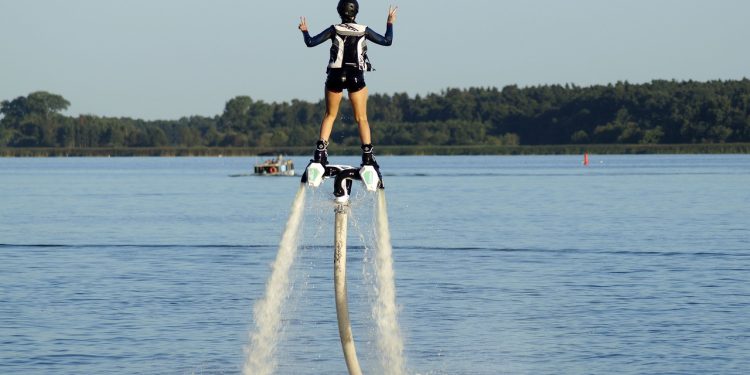Flyboarding is an electrifying water sport that gives you the sensation of flying over water, performing flips, spins, and impressive acrobatics. Combining elements of jet skiing, water skiing, and even snowboarding, flyboarding lets you rise above the waves with the power of pressurized water. Since its invention in 2012, flyboarding has become a popular choice for thrill-seekers looking for a new and exhilarating way to enjoy the water. Whether you’re completely new to flyboarding or you’re curious to give it a try, here’s everything you need to know to get started in this exciting sport.
1. What is Flyboarding?
Flyboarding involves standing on a board attached to a jet ski through a long hose. Water is sucked in by the jet ski’s motor and forced out through nozzles on the board, creating powerful streams that propel you into the air. A skilled instructor on the jet ski helps control the power, while you use your balance to maneuver the flyboard. Riders can hover above the water, dive in, or perform various tricks. Flyboarding may look complex, but with some guidance and practice, almost anyone can experience the thrill of flying.
The flyboard itself has a pair of boots fixed on the board, similar to snowboarding, along with two powerful jets that thrust water downwards. Your ability to balance, lean, and adjust your bodyweight will determine the direction and movement of the flyboard, giving you a great workout along with an unforgettable adrenaline rush.
2. Finding a Qualified Instructor
Before trying flyboarding, it’s essential to have a skilled instructor by your side. Most beginners will need the help of a certified instructor, especially for their first few sessions. Flyboarding involves coordination, strength, and balancing skills, but with the right guidance, you can pick it up quickly.
A qualified instructor will guide you through the basics of the sport, explain safety procedures, and help you get comfortable with the equipment. They will also control the throttle on the jet ski, determining how much pressure is being pumped through the board, which gives you more control to get used to the sensation of rising and balancing above the water. A great instructor can make the difference between a frustrating learning process and a successful, exhilarating first flight.
3. Choosing the Right Location
Location is an important factor for your first flyboarding experience. Ideally, you want calm water with minimal waves, such as a quiet bay or lake. This helps beginners find their balance more easily, without being thrown off by rough water. Many tourist destinations near the coast now offer flyboarding sessions, so if you’re on holiday near the beach, chances are you’ll have access to this fun activity.
Look for locations that have good reviews, certified instructors, and the right facilities to accommodate beginners. Some places have restrictions based on local regulations, so it’s also worth checking if any permits are required to try flyboarding in a particular location.
4. Wear the Right Gear
To fully enjoy the flyboarding experience, it’s crucial to wear the right gear. The two most important pieces of equipment are a personal flotation device (PFD) and a helmet. The PFD is mandatory and will keep you buoyant in the water, while the helmet protects your head from potential bumps or falls.
Most places that offer flyboarding will provide the necessary safety gear, including a wetsuit if needed. The wetsuit can keep you comfortable in colder waters, as it will help retain your body heat and make the experience more enjoyable. Remember to wear snug, form-fitting clothing under the wetsuit to prevent any discomfort when you fall into the water.
5. Mastering Basic Balance
Balance is key in flyboarding, and it can take a bit of practice to get it right. Your first goal will be to get used to standing on the board while the jets lift you into the air. Focus on keeping your legs straight and leaning back slightly. Bend your knees slightly to absorb any shock and make small, gentle movements to adjust your position.
The hardest part for many beginners is overcoming the initial wobbles and finding that sweet spot where the board balances. The key is not to overthink or overcompensate; instead, remain relaxed, and use subtle shifts in weight to control the board. Keep your gaze on the horizon rather than looking down at the water, which helps maintain stability and minimizes sudden tilting.
6. Learn to Control Height and Direction
Once you have gained confidence standing and balancing, the next step is learning to control the height and direction. A great way to start is by hovering just a few feet above the water until you feel comfortable. The instructor will typically control the throttle and help you find a manageable height.
The direction of the flyboard depends on how you lean your body. To move forward, lean slightly forward, and to turn, lean left or right. Use your feet to apply pressure to the corresponding side of the board. Learning to control the flyboard’s movement takes practice, but once you get the hang of it, you can start to explore the area around you, and even try some gentle turns or spins.
7. Falling with Style
Falling into the water is an inevitable part of learning to flyboard, and the key is to make sure you do it safely. Unlike other sports, falling in flyboarding is relatively safe due to the cushioning effect of water, but there are still some techniques that can make it easier. When you lose balance and start to fall, try to relax and let yourself go with the movement. Avoid tensing up or attempting to brace your fall, as this can lead to unnecessary strain.
Enter the water feet first whenever possible, and avoid landing face down or trying to catch yourself with your hands. Keeping your body relaxed will make the impact much gentler, and you’ll be ready to try again with minimal discomfort.
8. Practicing Tricks
Once you’ve gotten the hang of balancing and moving around, you can start practicing some basic tricks. Some of the popular tricks include dolphin dives, spins, and even flips. To perform a dolphin dive, you angle your body downwards towards the water, dive in, and then rise back up. It feels like diving and flying combined into one, and it’s one of the most exciting moves you can do on a flyboard.
Spins can be practiced by leaning into the direction you want to rotate while keeping your core engaged to maintain control. As you progress, you may even want to try backflips, although these are recommended only for advanced riders with plenty of practice and good instructor supervision. Tricks add a whole new level of fun to flyboarding, but always practice safely and avoid pushing your limits too quickly.
9. Strengthening Your Core and Legs
Flyboarding requires a combination of strength, balance, and coordination, with your core and leg muscles doing much of the work. You can prepare for flyboarding by incorporating exercises into your routine that target these areas. Squats, lunges, planks, and balance exercises will help you build the strength and stability needed to excel in flyboarding.
Yoga and Pilates are also excellent for enhancing your balance and flexibility, both of which are essential for flyboarding. A strong core will not only make balancing easier but will also reduce the risk of injury while making each movement feel more controlled.
10. Building Confidence Gradually
Confidence is key when flyboarding. It can be intimidating the first few times you’re propelled into the air, but as you gradually improve your balance and control, your confidence will grow. Start small by hovering just a few feet above the water until you feel comfortable, then slowly increase your height.
As you build confidence, try to set small, manageable goals for each session. Whether it’s staying airborne for a longer time or mastering a new turn, these goals will help you stay motivated while also providing a sense of achievement as you progress. With time, flyboarding will feel less daunting and more like the exhilarating experience that it truly is.
11. Understand the Safety Rules
Safety is paramount when flyboarding. Always listen to your instructor and follow their guidelines. Make sure that there is enough space around you, free from obstacles like boats, docks, or buoys. Flyboarding should always be done in a designated area where other watercraft won’t be an issue.
In case you are ever unsure about something, don’t hesitate to ask your instructor questions. Understanding what to do in different scenarios, such as losing balance, losing power, or dealing with other water users, will help you feel more in control and ready to handle anything that comes your way.
12. Have Fun and Enjoy the Ride
The most important tip for getting started with flyboarding is to enjoy every moment. Flyboarding is unlike any other water sport—it combines the sensation of flying, diving, and surfing all in one. There will be a learning curve, but with patience, you’ll soon find yourself rising above the water with confidence and skill.
Embrace the falls, celebrate the small victories, and make the most of each session. Flyboarding is a thrilling adventure that allows you to experience the freedom of soaring through the air and the joy of mastering new skills. With the right attitude, a good instructor, and a bit of practice, you’ll soon be soaring above the waves with a huge smile on your face.






